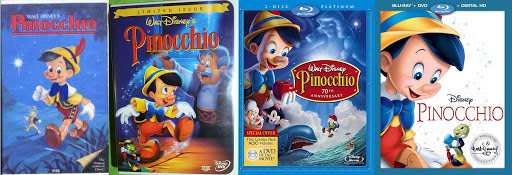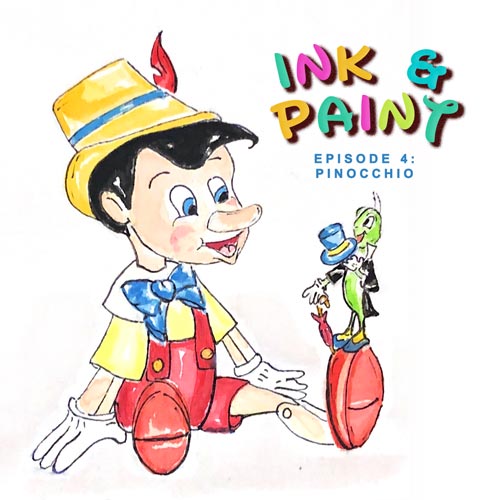Music ∷ Sam Porter
Show Artwork ∷ Nikolaos Pirounakis
Episode Artwork ∷ Lily Meek

Prove yourself brave, truthful and unselfish, and some day,
you will be a real boy.
Woodcarver Gepetto (voiced by Christian Rub) has constructed a wooden puppet he names Pinocchio (Dickie Jones), but wishes that Pinocchio was a real boy instead of being made of wood. His wish is granted by a Blue Fairy (Evelyn Venable), who brings Pinocchio to life but tells him that only through good deeds and bravery can he finally become a real boy. With his conscience and sidekick Jiminy Cricket (Cliff Edwards), Pinocchio begins to navigate the temptations of the world, making many mistakes along the way, until the consequences of his actions lead him on a mission to rescue a lost Gepetto from the belly of a whale at the bottom of the ocean. His bravery and selflessness lead to his wish finally being granted, and Pinocchio becomes a real boy.
'Pinocchio' is based on the story written by Carlo Collodi, first in serial form from 1881 and later published as a book as 'The Adventures of Pinocchio' in 1883. It has since been translated into over 300 languages, making it the most translated non-religious text. Animator Norman Ferguson drew Walt Disney’s attention to the book, and he later said that “Walt was bursting with enthusiasm” for it.
In late 1937, before 'Snow White' was released, Disney began to assemble a story team for 'Pinocchio'. Almost immediately, the film ran into problems, particularly around Pinocchio himself. Early versions kept the character closer to Collodi’s story, a wisecracking and strangely unlikeable character, and initial designs strongly emphasised him as a puppet. None of this expressed the empathy or charm that Disney had hoped for. Six months into development, he shut down production and ordered the team to start again.

Young animator Milt Kalh suggested that instead of approaching Pinnochio as a puppet, they should instead approach him as a little boy and apply the physical aspects of a puppet afterwards. This new approach suggested a Pinocchio more naive, innocent and endearing, even human, and a more potent tone for the character and the film began to take shape.

The film would represent a changing of the guard at Walt Disney Productions. The animators that had worked with the company on the early shorts, the Silly Symphonies and through to 'Snow White' were beginning to step back, and the younger animators were taking on bigger assignments. 'Pinocchio' would launch the careers of many of the animators who would define Disney Animation for the next four decades.

An integral part of the process at Disney was the Sweatbox sessions, where Walt Disney and his staff would review dailies and new material. It was named for the small, windowless room where the reviews took place during the early days at the Hyperion studios, but later for the anxiety of the animators showing their work under Walt’s critical eye. An early part of the process was a review of the story reel. Once the storyboards were completed and approved, they were photographed and constructed into a story reel, accompanied by temp voices and music. This meant that the film could be reviewed in its entirety in rough form before the animation work began. The early reels were shot with a Leica camera, and so the reels became known as Leica Reels. A stenographer would take notes during the sweatbox sessions, so full records of those discussions exist for posterity.

They also created working models of Stromboli’s wagon and the Coachman’s coach that were used for rotoscoping. They were filmed as live-action, rolling over a treadmill, then the frames were blown up to the size of animation paper and wash-off reliefs were made. The reliefs were then painted as you would with traditional cel animation, and incorporated into the rest of the scene.
If 'Snow White' had been a grand experiment to see what was even possible in feature film animation, Pinocchio was a confident and rigorous step forward, a solidifying of the practices that are still integral to the process of developing and realising an animated film.
I think that I can safely say that all of us who were involved, you know, on the ‘Pinocchio’ picture, felt that we were going leaps and bounds, not only technically but storytelling-wise and in animation and in colour and design, we were going beyond what we had achieved on ‘Snow White’, which was pretty good. We were able to immerse ourselves in this atmosphere, so in animation and in backgrounds, they all fit, everything began to work together.
For nearly fifty years, the method behind this shot and many of the technical achievements in 'Pinocchio' and 'Fantasia' had been a mystery. The technicians and artists at the time had been so preoccupied with solving Disney’s artistic challenges that they had not bothered to document their process. However, in 1990, a collection of notebooks were found in the home of the recently deceased widow Ethel Schultheis, whose husband Herman had worked in the Special Effects department at the studio in the late ’30s.

Hidden and forgotten inside a Murphy bed, one of the notebooks turned out to be a detailed record of many of the techniques used during the making of the first animated features, including extensive photographs, sketches and calculations. Schultheis had attempted to sell the notebook to the studio in 1939, but Disney hadn’t been interested. Today, Herman Schultheis’ notebook is one of the most valuable documents on the development of the medium, and is regarded as "the Rosetta stone of Disney animation". The notebook is now on display at the Disney Family History Museum in San Francisco, and an annotated reproduction was published in 2014. Without it, we would have no idea how much of the incredible work in these great films was achieved.

All of 'Pinocchio' was still animated at Hyperion, but the camera and sound departments were the first to move, so that a lot of their work - including the score and voice recordings - was completed at the new studio. Disney wanted this new campus to be the heart of animation in America, an artistic utopia designed specifically to deliver the best the medium was capable of. At the height of production, over 1,000 people were working for the company, more and more artists being drawn from rival studios and to study at the feet of the great masters. The studio even became a hub for visiting celebrities and dignitaries. Where the Hyperion studio had been a ramshackle set of dreams built on top of one another, Burbank would weave those dreams into a kingdom, with Disney as the benevolent head of state.
- STORY: The initial story pitch took two days to get through before cutting and refining began.
- STORY/ANIMATION: Jiminy Cricket greatly expanded on the cricket character from Collodi’s book, and was the first of the Disney sidekick characters. He was included because Disney was concerned that Pinocchio was too helpless and easily led astray, but the design went through similar issues as Pinocchio. The initial approach was closer to an actual cricket, but it never seemed to work. Animator Ward Kimbell eventually cracked the design, making him instead ‘a little man with a big head’. Disney approved, and justified the design by saying, ‘He’s a cricket because we call him one’.
- ANIMATION: Most of the animation of Monstro the Whale was rendered in charcoal on a papel level on the animation, an incredibly tricky process.
- VOICE: Cliff Edwards, the vaudeville star who voiced Jiminy Cricket, was the first celebrity ever to give a voice performance in animation.
- VOICE: Gideon the Cat originally had dialogue, but it was later decided that he would be better as a pantomime character. Dialogue was recorded though with legendary voice actor Mel Blanc, who would go on to be the voice of Bugs Bunny at Warner Bros. The only part of his performance that remains is Gideon’s hiccup.
- SOUND: To achieve the effect of voices underwater, the dialogue was recorded on 35mm film, run incorrectly through a projector so it would get stuck and the distortion this caused on the sound was recorded. It became known as the Butterfly Machine.
You really have to stop yourself and say, that was all blank paper. This all began as blank paper. It doesn’t exist.

'Pinocchio' took two years to complete, half the time but double the budget as 'Snow White'. It had been an enormous emotional and financial strain on the studio and on Disney himself, who was delivered a devastating personal blow when his mother suddenly died of carbon monoxide poisoning in 1938. He had also taken a step back from the film, both because of distractions from 'Fantasia', 'Bambi' and the new studio, but also out of frustration. The process had not been as smooth as Snow White, and he had found himself easily annoyed by its troubled progress.
When it was released through RKO Pictures on the 7th February 1940, the critical response to 'Pinocchio' was even greater than that for its predecessor, but the film itself bombed at the box office, only making $1 million on its initial run against a budget over $2 million. While 'Snow White' was released as the Great Depression was coming to an end, 'Pinocchio' was released at the start of the Second World War in Europe, and the loss of both the European and Asian markets, along with its enormous budget, are often sighted as the reason for its financial failure. The film had eaten away a large chunk of the profits from 'Snow White', and with the financial strain of building the new studio, Roy convinced Walt that the company needed to go public, something both Disney brothers had always resisted. In April 1940, they issued 150,000 shares, bringing in around $4 million for the company. As reassurance for their investors, a $1.5 million life insurance policy was taken out on Walt.
Almost immediately, the fortunes of the film began to shift. It became the first feature animated film to win a competitive Oscar, with wins for Best Score and Best Song (‘When You Wish Upon A Star’), a win the company wouldn’t repeat again until Mary Poppins in 1964. By 1945, the film had made back its budget through its first re-release and joined 'Snow White' in regular re-release.
Basically, ‘Pinocchio’ is the ultimate expression of what is possible in the craft of animation.
Today, 'Pinocchio' is regarded as one of the greatest animated films ever made. It has been praised as a major technical achievement and a powerful morality tale on the nature of right and wrong, consequence and responsibility. Eighty years after its release, it has lost none of its power, especially the sense of danger and the nightmarish images at Pleasure Island.
'Pinocchio' is just a wooden boy who is trying to be human. One would think that that means he can make mistakes, that he would be allowed to have the faults of being a boy. And instead, any indiscretion is met with the possible death of his adopted father, or the transformation into a donkey. The stakes are so very high.
In 1994, 'Pinocchio' was added to the United States National Film Registry, and is consistently included in lists, not just of the best animated films, such as ranking second behind 'Snow White' in the AFI 100 animated films list, but the best films of any kind from across the history of cinema. For animators around the world and over the last 80 years, it is still seen as one of the highest points their medium has ever reached. "With Pinocchio”, wrote film critic Leonard Maltin, “Disney reached not only the height of his powers, but the apex of what many critics consider to be the realm of the animated cartoon."
In 1940 though, Walt Disney did not know what 'Pinocchio’s' legacy would be. Many believed that he had transcended the artistic successes of 'Snow White and the Seven Dwarfs', but despite the gargantuan work involved and the tremendous evolution of the form, he was now dealing with his first box office failure. There was no time to take a breath though. He now turned his attention to the remaining slate of films, including the adaptation of 'Bambi' and a new, small-scale project about a baby elephant who could fly. Before that, however, would be the most ambitious technical and artistic film enterprise he would ever embark on, one that attempted to solidify animation as a legitimate art form, would change the technology of cinema itself and bring the company even closer to the edge of collapse.
Walt Disney has created something that will be counted in our favour, in all our favours, when this generation is being appraised by the generations of the future, for it will be said that no generation which produced a ‘Snow White’ or a ‘Pinocchio’ could have been altogether bad.

- Pinocchio received its first home video release on VHS and Laserdisc in July 1985, the second film in Walt Disney Classics label. It was again reissued in 1986 to advertise the VHS debut of 'Sleeping Beauty'.
- A digital restoration prepared for its 1992 theatrical run was released on VHS in 1993.
- It made its DVD debut as a 60th Anniversary Edition in 1999, as well as a second release in 2000, both accompanied by VHS releases. It was returned to the Disney Vault in January 2002.
- A new high-definition restoration from Lowry Digital was used for its first two-disc Blu-ray release in March 2009 as the final titles in the Platinum Edition series, and included an extensive in-cinema PiP feature to accompany the film. It was returned to the vault in April 2011, though it began to reappear a few years later in territories outside of the United States.
- The most recent single-disc Blu-ray edition, as the first title in the Signature Edition series, was released in January 2017, and as with all titles in that series, uses the previous restoration, includes a smattering of new features and removes a number of others. This coincided with its first Digital HD release. At this stage, this edition is still readily available, and along with the majority of the Disney Animation canon, is available on Disney+.
- Wikipedia on Pinocchio
- Pinocchio: Platinum Edition, two-disc Blu-ray, 2009
- American Experience: Walt Disney, dir. Sarah Colt, PBS, 2015
- The Disney Studio Story, Richard Hollis and Brian Sibley, 1988
- The Lost Notebook: Herman Schultheis & The Secrets Of Walt Disney's Movie Magic, John Canemaker, 2014
- Walt Disney: The Triumph of the American Imagination, Neal Gabler, 2006













